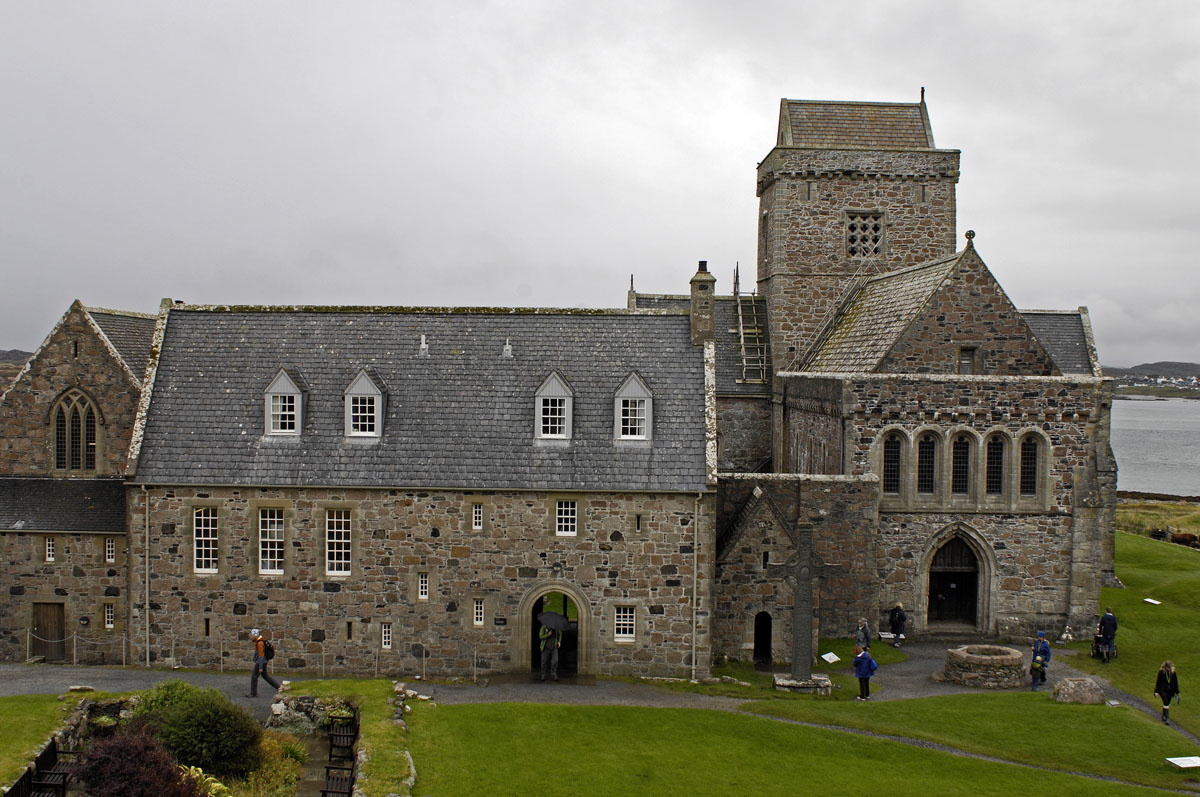
Click here for high-resolution version.
The abbey on Iona is a heavily visited tourist destination. It was, easily, the least interesting place on the four Scottish islands that Ken and I visited — Mull, Ulva, Gometra, and Iona. The isle of Iona itself, though small, is fertile and beautiful. But, to me, the abbey is just another outpost of the ugly Roman religion, which as it metastasized over the centuries destroyed superior cultures on earth as effectively and mercilessly as a mile-wide asteroid.
The abbey on Iona was founded by Saint Columba, who was from Ireland, in 563. Some archeological remnants of the early settlement remain, but the current building dates from the 13th Century. The building has been heavily restored and is now packed with tourists, many of whom seem to consider visiting Iona a kind of New Age pilgrimage. I always get a bad vibe from evangelicals. I felt that bad vibe very strongly on Iona, particularly inside the church, which has a loft fitted out with all the electronics that is used these days for “praise” music in evangelical churches. It’s an odd mixture — such an old church with such hip (and probably made in America) music. But they’re definitely raking in the dough, just as Saint Columba did by catering to rich clan chieftains.
According to Wikipedia, Saint Columba was the great-great grandson of Niall of the Nine Hostages, the 5th Century Irish king who is said to have brought Patrick to Ireland. Though King Niall, technically, is prehistoric, there is all sorts of evidence, including genetic evidence, that he was a real person and that he left a great many descendants. In fact, DNA testing shows that I have the genetic marker of Niall’s descendants (the marker is common in Ireland, especially in the north). However, if I am descended from Niall, the greater-by-far odds are that I’m of bastard descent, whereas Columba was legitimate. Though the interpretation of the Y-chromosome marker for Niall’s descendants has been questioned, nevertheless I interpret the DNA evidence as a pretty reliable indicator that my own pagan ancestors were in Ireland during the 5th Century. Thus my own ancestors were caught up in the Christianization of Ireland and Scotland. For that reason, I take rather personally what I see as genocide — the Christian destruction of pagan cultures. To me, the saints Patrick and Columba represent an enduring shame, as those of us who live in Christianized cultures continue the work of throwing the Roman religion off our backs — its crummy texts, its infantile (and borrowed) stories, and its ossified and primitive notions about ethics, morality, and epistemology, which in spite of the Enlightenment still exert their 13th-Century influence, poisoning our politics and ruining the minds it touches.
I apologize for the rant. But I hated the abbey on Iona, and I grieve for what the place stands for.

Preach it, brother!
So, I get that you didn’t like the Abbey . What about the island? Are you blaming the Romans or the Catholic Church (I always get those two mixed up)?
The island itself is a gem. As the tour guide said, the island is remote at present. But centuries ago, when people in the area traveled mostly by water, Iona was in a prime location for sea traffic. There are beautiful rock-free fields and gardens on Iona, no doubt because the island has been inhabited for so long and the rocks have been cleared.
In the last years of Rome, under Christian emperors, Rome and the Roman religion really were the same thing. Julian (332-363) was the last non-Christian emperor. As the Roman empire in the west fell apart around 500 A.D., the church’s popes and bishops continued to proselytize and build their power.
It we wanted to pick a date for when it was all over for pagan Britain, that would surely be 597 A.D., when Pope Gregory sent a mission of 40 monks to southern Britain, led by Augustine of Canterbury. By then, Columba already has his toehold on Iona (563 A.D.).